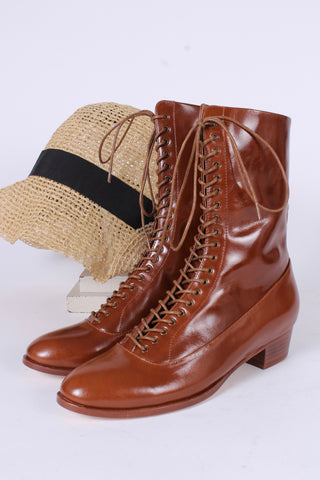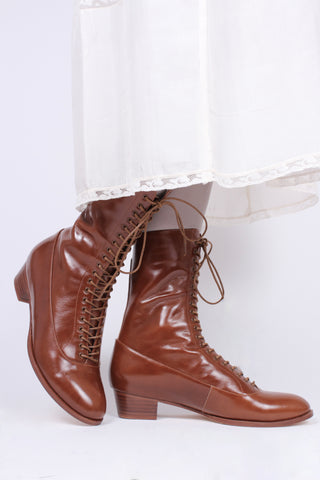1920's shoes and boots
Classic, everyday late 1920's pumps - Cognac brown- Charlotte
€199,00
- Unit price
- /per
2 colors
1930s evening shoe with T-strap crafted from leather and suede - Black - Wilma
€195,00
- Unit price
- /per
Early 30s pump with double ankle straps - Cognac brown - Judy
€194,00
- Unit price
- /per
2 colors
Early 30s pump with double ankle straps - Dark brown - Judy
€194,00
- Unit price
- /per
2 colors
1910s / 1920s style everyday leather boot - Brown - Britta
€239,00
- Unit price
- /per
2 colors
1910s / 1920s style everyday leather boot - Black - Britta
€239,00
- Unit price
- /per
2 colors
Men's late 20s / 30s style everyday leather ankle boot - Black - Tom
€229,00
- Unit price
- /per
2 colors
Men's Edwardian 10s / 20s style ankle leather boot - Cognac brown - William
€229,00
- Unit price
- /per
Men's late 20s / 30s style everyday leather ankle boot - Dark brown - Tom
€229,00
- Unit price
- /per
2 colors
You’re viewing 1-32 of 32 products
FAQ: 1920s Footwear: Mary Janes, French Heels, and Flapper Style
Women’s shoes in the 1920s gained prominence due to the shorter dress lengths, highlighting footwear in new ways. Mary Jane shoes, featuring either a single strap or T-strap across the instep, were particularly fashionable. These shoes often had the distinctive curvy French heel, which remained popular from the 1910s. Typically made from leather or satin, Mary Janes came in a variety of colors—while black was a classic choice, shades like cream and red gained popularity, as did metallic tones such as silver and gold.
Although the curved French heel remained a prominent style after the 1900s and 1910s, flat shoes were also commonly worn in the 1920s. Mary Jane shoes often came in flat-heeled versions, and Oxford shoes, which were widely popular as everyday walking shoes, were available with either low or flat heels.
Flapper girls of the 1920s often opted for Mary Jane shoes with the iconic curved French heel. While black was a traditional color, flappers also embraced bold options like red and metallics such as gold or silver. A variation of the Mary Jane was the T-strap, where the strap formed a “T” shape across the instep.
Mary Jane shoes, also known as bar shoes, are a classic women’s shoe characterized by an open design and a strap across the instep. Traditionally black, these shoes can also be found in colors such as red, dark blue, and cream. The T-strap variation, where the strap forms a "T," was also popular. Named after the character Mary Jane from the 1902 comic strip Buster Brown, these shoes were initially designed for children.
1920s Fashion: A Revolution in Style and Society, Marked by Art Deco, Flapper Trends, and Post-War Influence
The fashion of the 1920s, often referred to as the "Roaring Twenties," was characterized by significant shifts in both style and societal norms, heavily influenced by World War I (1914-1917). This era of economic prosperity and cultural change saw women gaining voting rights in several nations, with many continuing to work in traditionally male-dominated fields they had entered during the war, embracing newfound financial independence. The public also enjoyed increased access to entertainment such as jazz, cinema, and nightclubs, reflecting a broader cultural liberation and a more relaxed approach to social conventions. With workers and women gaining more rights, there was also a growing focus on leisure activities, including sports. The ornate, flowing designs of Art Nouveau were replaced by the cleaner, more streamlined aesthetic of Art Deco.
In women’s fashion, the 1920s marked a distinct departure from the formal attire of earlier periods. The flapper style, or "La Garçonne," was particularly popular with younger women, featuring knee-length dresses with low, drop waistlines that created a straight silhouette, moving away from the traditional emphasis on feminine curves shaped by corsets. Short hairstyles like the bob, often styled with finger waves, became fashionable, as did bold makeup, contrasting with the previously understated beauty standards.
Dresses were typically made from lightweight fabrics like silk, chiffon, and velvet, embellished with embroidery, sequins, and beads, especially for eveningwear. Cloche hats, inspired by military helmets from World War I, were worn low on the forehead and decorated with bands or flowers. Women’s footwear, still featuring the French heel popular from previous decades, also adapted to the shorter hemlines of the time. Mary Jane shoes, with a single strap across the instep, were widely worn, and shoes were crafted from leather or satin in various colors, with red and cream particularly fashionable. Metallic tones such as gold and silver were commonly seen in evening shoes.
For men, the 1920s represented a period of modernization in fashion, though the changes were less dramatic than for women. Most men wore suits daily, with jackets and trousers becoming more narrow to create a sleek, elegant silhouette. The three-piece suit, consisting of a vest, trousers, and jacket, was a staple, and striped suits became more prevalent. Leisure activities were also reflected in fashion, with specific outfits for driving, golfing, or skiing, including casual items like knickerbockers, shirts with scarves, and straw hats or newspaper caps.
Footwear for men included Oxford shoes and two-tone styles, often in black and white or brown and white. Leather lace-up boots with a more rounded toe were also popular in black or brown.
Sources:
- Shoes: An Illustrated Story by Rebecca Shawcross
- Tidens Mode by Anne-Grete Steckhahn
- Vintage Fashion: Collecting and Wearing Designer Classics by Emma Baxter-Wright, Karen Clarkson, Sarah Kennedy, and Kate Mulvey
- Vintage Shoes by Caroline Cox





































































